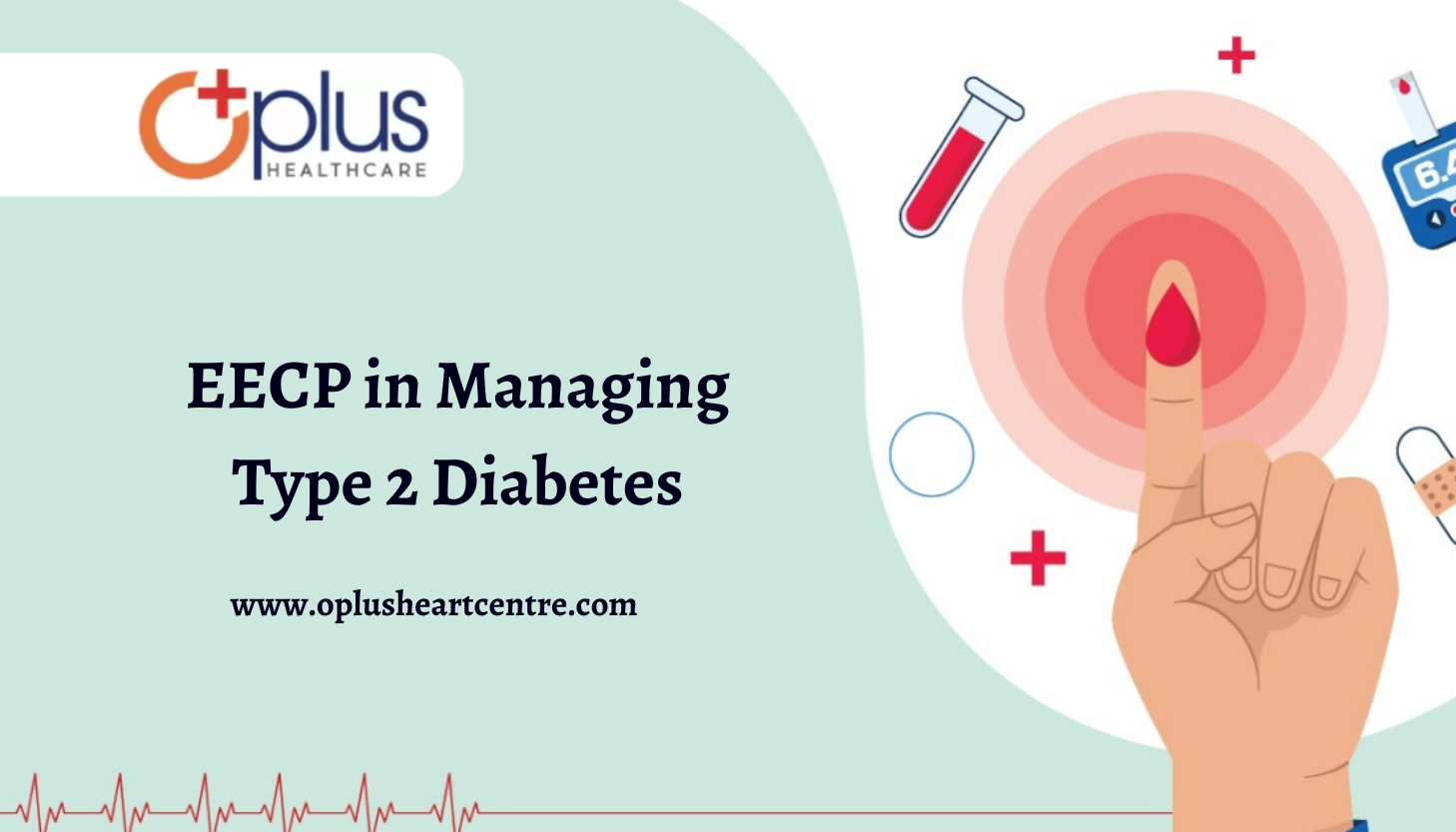- 12 June 2024
EECP in Managing Type 2 Diabetes: Type II diabetes stands as a worldwide health crisis, affecting countless individuals on a daily basis, with the potential for severe health complications. Given this urgency, the pursuit of effective treatment avenues is paramount. Among these avenues, Enhanced External Counter-pulsation (EECP) has emerged as a noteworthy contender. Initially utilized in heart condition management, EECP has recently garnered attention for its potential to address Type II diabetes.
As a non-invasive procedure, EECP operates by enhancing blood circulation, a mechanism with profound implications for blood glucose regulation. In this blog, we will thoroughly examine the mechanics of EECP, its influence on blood sugar control, and its broader implications for managing Type II diabetes.
Our exploration will encompass the scientific underpinnings of this therapy, its tangible benefits for diabetic individuals, and considerations regarding potential side effects. Through real-life case studies, we will spotlight the success stories of those who have effectively managed their diabetes with EECP’s assistance. Come along as we delve into the promising role of EECP in the ongoing battle against Type II diabetes.
Getting To Know Type 2 Diabetes
Type II diabetes, also known as adult-onset or non-insulin-dependent diabetes, is a persistent health concern affecting the body’s glucose (sugar) utilization process. Unlike type I diabetes, characterized by insufficient insulin production, type II diabetes manifests as either resistance to insulin’s effects or inadequate insulin production, leading to imbalanced glucose levels. This form of diabetes typically develops gradually and is commonly diagnosed in adults, though its occurrence in children is rising due to escalating obesity rates. Lifestyle factors such as poor dietary choices, inadequate physical activity, and excess weight play a significant role, alongside hereditary influences.
Typical symptoms encompass frequent urination, heightened thirst and hunger, fatigue, blurred vision, and delayed wound healing. Left unmanaged, elevated blood sugar levels pose serious health risks, including heart complications, strokes, kidney issues, eye problems, and nerve damage.
The management of type II diabetes typically involves lifestyle adjustments, medication usage, and occasionally, insulin therapy. Nevertheless, ongoing research continually explores novel approaches to control this condition, one of which is Enhanced External Counter-pulsation therapy, or EECP therapy, a topic we’ll delve into further in this blog.
Exploring Enhanced External Counter-pulsation (EECP) Therapy
Enhanced External Counter-pulsation (EECP) therapy is a non-invasive outpatient approach primarily employed to alleviate symptoms in patients with specific heart conditions like angina and heart failure. However, recent studies propose its potential benefits extend to individuals grappling with Type II diabetes.
During EECP therapy, sizable inflatable cuffs, akin to blood pressure cuffs, encase the patient’s legs and buttocks. These cuffs inflate and deflate rhythmically in tandem with each heartbeat. Inflation occurs during the heart’s relaxation phase (diastole), generating a retrograde arterial wave that bolsters blood flow returning to the heart. This process aims to foster the development of new blood vessels and enhance circulation, thereby diminishing the heart’s workload and oxygen demands.
The perceived advantages of EECP for those with Type II diabetes are believed to hinge on its capacity to augment blood flow. Improved circulation can enhance insulin utilization and blood sugar regulation, potentially mitigating the severity of diabetes symptoms and complications. Nonetheless, further investigation is necessary to comprehensively grasp and authenticate these effects. It’s crucial to acknowledge that EECP is typically considered when conventional treatments have proven ineffective or unsuitable, and its administration should be overseen by a qualified healthcare provider.
Mechanism Behind EECP: How Does it Operate?
Enhanced External Counter-pulsation (EECP) therapy functions akin to an intra-aortic balloon pump (IABP), employing external pressure pulses to boost coronary blood flow. This therapy utilizes three sets of pneumatic cuffs that sequentially contract during the heart’s rest phase, known as diastole. This sequential contraction elevates aortic diastolic pressure, thereby enhancing coronary blood flow. Through its pressure wave, EECP directly dilates existing vessels within the myocardium while also augmenting shear stress in the vasculature, fostering coronary vasodilation and angiogenesis.
The fundamental principle of EECP treatment revolves around bolstering blood return to the heart, thereby enhancing oxygen supply to deprived areas. It may achieve this by potentially opening pre-existing collateral channels, either directly through increased diastolic pressure or indirectly via alternative mechanisms. Another potential avenue for EECP’s beneficial effects lies in its impact on nitric oxide bioavailability, potentially leading to reduced levels of plasma inflammatory markers.
In essence, EECP operates by enhancing venous return, augmenting peripheral resistance, and ultimately improving the cardiac index.
EECP in Managing Type 2 Diabetes
Enhanced External Counter-pulsation (EECP) therapy not only benefits cardiovascular health but also demonstrates promising outcomes in blood sugar level management. Research indicates that EECP treatment can enhance glucose metabolism, offering potential advantages for individuals managing diabetes.
In a study involving patients with metabolic syndrome, EECP therapy resulted in a noteworthy decrease in fasting blood glucose levels and insulin resistance. This suggests that EECP could potentially enhance insulin sensitivity. Additionally, the therapy may stimulate the secretion of certain hormones crucial for blood sugar regulation. For instance, EECP has been shown to elevate levels of glucagon-like peptide-1 (GLP-1), a hormone that boosts insulin secretion and suppresses glucagon release, thereby reducing blood sugar levels.
Furthermore, the overall enhancement of cardiovascular function facilitated by EECP might indirectly contribute to improved glucose control. Enhanced blood flow and oxygen delivery to the muscles can optimize glucose utilization, aiding in the maintenance of balanced blood sugar levels.
Benefits and Potential Side Effects of EECP for Type II Diabetes Patients
Benefits of EECP for Type II Diabetes Patients
- Enhanced Glycemic Control: EECP therapy aids in regulating blood sugar levels, mitigating risks associated with elevated blood glucose
- Improved Blood Flow: EECP enhances blood circulation to various organs, augmenting the body’s insulin utilization.
- Cardiovascular Health: EECP treatment enhances coronary flow reserve and alleviates angina symptoms, assisting in managing cardiovascular complications commonly observed in diabetes patients.
- Reduced Medication Dependency: EECP therapy has, in certain instances, reduced the necessity for medication, alleviating the physical and financial burdens of diabetes management.
Potential Side Effects of EECP for oType II Diabetes Patients
- Skin Irritation or Bruising: The cuffs utilized during the procedure may induce minor skin irritation or bruising, typically resolving on their own.
- Fatigue: Post-treatment, patients may experience tiredness or fatigue, which typically diminishes over time as the body acclimatizes to improved circulation.
It’s essential to remember that all treatment decisions should be made under the guidance of a healthcare professional. While the benefits of EECP often outweigh the side effects, it’s crucial to consider all factors.
How EECP Aids in Managing Type II Diabetes At Oplus Heart Centre?
Enhanced External Counterpulsation (EECP) serves as a non-invasive treatment utilizing inflatable cuffs to augment blood return to the heart. Initially employed primarily for angina therapy, recent studies have suggested potential benefits for Type II Diabetes management as well.
Research indicates that EECP therapy exhibits promise in enhancing glycemic control in individuals with non-insulin-dependent Type II Diabetes. This treatment mechanism enhances blood flow and circulation throughout the body, contributing to blood sugar level regulation. An advantageous aspect of EECP is its non-invasive nature, making it an appealing option for those seeking alternative approaches to manage Type II Diabetes.



